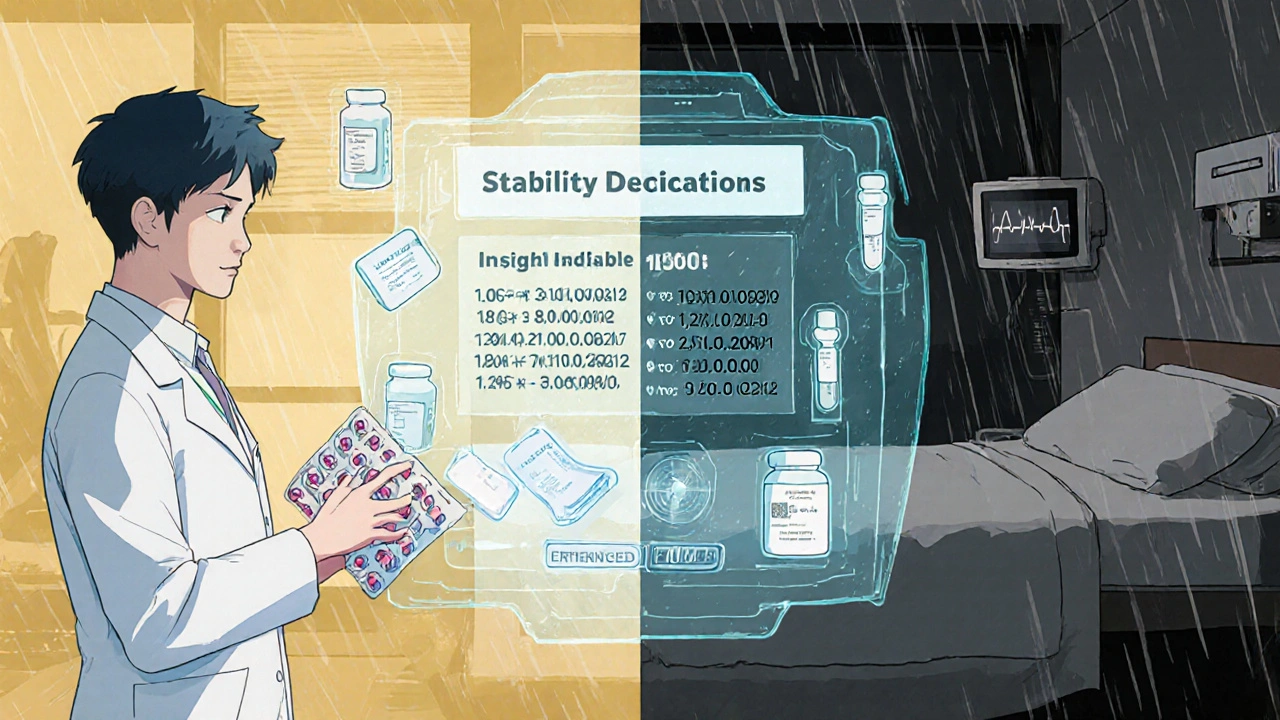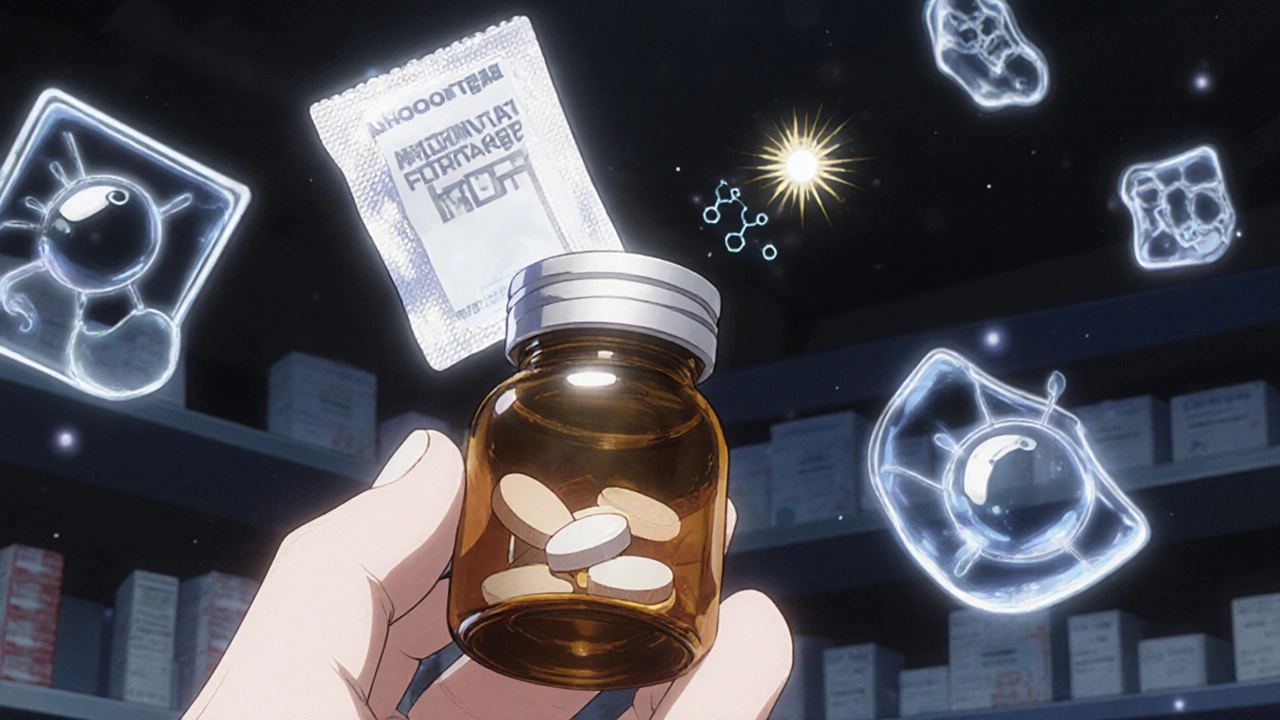When you take a medication out of its original bottle and put it into a pillbox or a pharmacy repackaging vial, you’re changing its environment-and that can change how long it stays safe and effective. Many people assume the expiration date on the original bottle still applies. It doesn’t. And that’s not just a technicality-it’s a safety issue.
Why Original Expiration Dates Don’t Apply to Repackaged Medications
Manufacturers test their drugs under strict conditions: sealed in original containers with desiccants, light-blocking materials, and precise humidity controls. These packages are designed to keep the drug stable for years. But once you move a pill into a plastic vial or a plastic pill organizer, you’re exposing it to air, moisture, and light in ways the manufacturer never tested. The FDA makes this clear: you can only use the original expiration date if the drug stays in its original container with all its protective features intact. Once it’s repackaged, that clock resets. A 2023 FDA warning letter to a major pharmacy chain cited this exact failure-assigning the original expiration date to repackaged pills-as a critical violation that led to a 45-day shutdown of their repackaging operations.What Degradation Looks Like in Repackaged Drugs
Medications don’t just suddenly stop working. They degrade slowly, often in ways you can’t see. Common degradation pathways include:- Moisture absorption: Drugs like amoxicillin, cephalexin, or aspirin break down when exposed to humidity. A study in the Journal of Pharmaceutical Sciences found albuterol sulfate tablets lost over 15% of their potency in 90 days when stored in standard pharmacy vials-compared to just 3% in the original bottle with desiccant.
- Oxidation: Drugs like nifedipine or nitroglycerin are sensitive to oxygen. Even brief exposure can reduce effectiveness.
- Light exposure: Light-sensitive drugs like doxycycline or furosemide can discolor and degrade if stored in clear containers.
- Physical changes: Pills can cake together, stick to each other, or change color. In pillboxes with multiple drugs, 18.7% of combinations showed physical interactions within two weeks, according to the American Pharmacists Association.
How Long Can Repackaged Medications Last?
There’s no one-size-fits-all answer. Stability depends on the drug, the container, and the storage conditions. But experts agree on some key limits:- 30 days: For highly hygroscopic drugs like amoxicillin, doxycycline, or levothyroxine. These absorb moisture like a sponge. Even with desiccant packs, 30 days is the max.
- 60 days: For light-sensitive drugs like nifedipine, risperidone, or chlorpromazine. Amber vials help, but don’t eliminate risk.
- 90 days: For relatively stable drugs like atenolol, metformin, or simvastatin-only if stored in a cool, dry place and protected from light.
- 6 months: The absolute maximum for any solid oral dosage form under standard pharmacy conditions, according to the International Pharmaceutical Federation (FIP). Even then, only if testing supports it.

What You Need to Test for Stability
If you’re a pharmacist or pharmacy technician responsible for repackaging, you need a protocol. You don’t need a full lab, but you need a system. Step 1: Identify high-risk drugs Not all medications need the same level of testing. The ASHP recommends a tiered approach:- High-risk: Narrow therapeutic index drugs (warfarin, digoxin, lithium), chemotherapy agents, biologics, and any drug with known instability. These require formal stability testing using HPLC.
- Medium-risk: Drugs prone to moisture or light degradation (antibiotics, antifungals, some antihypertensives). Use bracketing-group similar drugs and test one representative.
- Low-risk: Stable, non-hygroscopic drugs like acetaminophen or ibuprofen. Conservative dating (60-90 days) is usually sufficient.
- Drug name and strength
- Original manufacturer and lot number
- Container type (vial, blister, pillbox)
- Storage conditions
- Assigned expiration date
- Testing method used (or rationale if relying on bracketing)
Pillbox Medications Are a Special Risk
Pillboxes are convenient-but they’re also the most uncontrolled environment for medications. When you mix 5-10 different drugs into one plastic box, you’re creating a chemical cocktail no manufacturer ever tested.- Moisture from one drug can migrate and destabilize another.
- Chemical interactions can cause discoloration or caking.
- Some drugs (like thyroid meds) are so sensitive they can be affected by even trace moisture from other pills.

What If You Don’t Have a Lab?
Most community pharmacies don’t have HPLC machines. That doesn’t mean you can’t do this safely.- Use the University of Florida’s Web-based Stability Database, which now has evidence-based expiration dates for over 1,800 repackaged medication scenarios.
- Follow manufacturer recommendations-even if they’re not on the label. Many drug inserts include stability data for repackaging.
- Use desiccant packs. A multicenter trial with over 8,400 repackaged units showed desiccants extended stability by 47%.
- When in doubt, use the shortest safe expiration: 30 days for anything uncertain.
What’s Changing in 2025
Regulations are catching up. The USP is finalizing General Chapter <1790> Repackaged Drug Product Stability by the end of 2024. It will require:- Minimum 12 units tested per timepoint
- At least 3 testing intervals for drugs used under 90 days
- Standardized container integrity testing
Bottom Line: When in Doubt, Date It Short
The biggest mistake pharmacists make is assuming repackaged drugs last as long as the original bottle. They don’t. And patients rely on you to know that.- Never use the original expiration date on repackaged drugs.
- Use 30-90 days as your default, depending on the drug.
- Always use desiccants and amber containers when possible.
- Document your decisions.
- When you’re unsure, err on the side of caution.
Can I use the original expiration date on repackaged medications?
No. The original expiration date only applies if the medication remains in its original manufacturer’s container with all protective features (desiccant, sealed closure, light-blocking material). Once a drug is repackaged into a pharmacy vial or pillbox, the expiration date must be reassessed and shortened based on stability data. The FDA explicitly states that using the original date on repackaged products is a regulatory violation.
How do I know if a repackaged drug has degraded?
Visible signs include discoloration, crumbling, caking, unusual odor, or sticking together. But many degraded drugs show no visible changes. The only reliable way to detect degradation is through stability testing using methods like HPLC, which can identify chemical breakdown products at levels as low as 0.05%. If you can’t test, assume the drug may have lost potency after 30-90 days and use conservative expiration dates.
Are pillboxes safe for long-term use?
Pillboxes are convenient but risky for long-term storage. When multiple drugs are combined, chemical interactions can occur within days. Moisture, heat, and light exposure increase, and there’s no barrier protection. For high-risk medications (like blood thinners or thyroid drugs), use individual blister packs or single-compartment organizers. Never reuse a pillbox for a new medication without cleaning it thoroughly. Limit pillbox use to 14-30 days max unless stability testing supports longer use.
Do desiccant packs really help?
Yes. A multicenter trial involving over 8,400 repackaged medication units showed that adding desiccant packs extended stability by 47%. This is especially critical for hygroscopic drugs like amoxicillin, levothyroxine, and aspirin. Always include a desiccant in repackaged containers unless the drug is known to be moisture-stable and the container is sealed with low moisture permeability.
What’s the maximum expiration date allowed for repackaged medications?
The maximum recommended expiration date for any solid oral repackaged medication is 6 months under standard pharmacy storage conditions, according to the International Pharmaceutical Federation. However, many states impose stricter limits: 30-90 days for moisture-sensitive or light-sensitive drugs. Always check your state pharmacy board regulations. For most community pharmacies, 30-90 days is the practical and legally safe range.
Do I need an HPLC machine to test repackaged drugs?
No, but you need a reliable method. Most community pharmacies don’t have HPLC equipment. Instead, use evidence-based databases like the University of Florida’s Web-based Stability Database, which provides tested expiration dates for over 1,800 repackaged medications. You can also use bracketing-grouping similar drugs and testing one representative-or follow manufacturer guidelines. When in doubt, use the shortest safe expiration: 30 days.
What happens if I don’t follow stability protocols?
The consequences can be severe. In 2023, the FDA shut down a major pharmacy chain’s repackaging operations for failing to assign proper expiration dates. Patients may receive ineffective or unsafe medication, leading to treatment failure, hospitalization, or death. Pharmacies can face fines, loss of licensure, or lawsuits. Even if no harm occurs, failing to document stability procedures is a violation of FDA and state regulations.


10 Comments
November 18, 2025 Shilpi Tiwari
Okay, so let me get this straight - the FDA shut down a whole repackaging operation because someone assumed expiration dates transfer? That’s not just a violation, that’s a systemic failure in training. The ASHP tiered risk model is solid, but most community pharmacies don’t even have a designated stability officer. We’re relying on techs who learned this from a 10-minute handout. And don’t get me started on how many ‘high-risk’ meds are being repackaged without even a desiccant pack. This isn’t negligence - it’s institutionalized recklessness.
Also, 18.7% of pillbox combinations show physical interactions in 14 days? That’s not a statistic - that’s a ticking time bomb. I’ve seen levothyroxine pills turn chalky next to metformin. No one notices until the patient’s TSH spikes. We need mandatory stability labeling on every pillbox - like nutritional facts on food. It’s not too much to ask.
And yes, the University of Florida database is gold. But if your pharmacy doesn’t have internet access during filling hours? You’re screwed. We need offline PDFs, printed cheat sheets, laminated cards. This shouldn’t be a PhD-level competency. It should be as routine as washing hands.
Also, why is there no FDA-approved pillbox material standard? Plastic is porous. Glass is heavy. Why aren’t we developing low-MVTR, light-blocking, antimicrobial pillbox materials? This is 2025. We’ve got smart packaging for cigarettes. Why not for life-saving meds?
November 20, 2025 Christine Eslinger
Thank you for writing this. Seriously. I’ve been a pharmacist for 22 years, and I’ve seen too many patients come in with pillboxes full of meds that are 6 months old - and they’re convinced they’re still good. One woman was taking her expired warfarin because ‘it still looks the same.’
It breaks my heart. We’re not just talking about potency - we’re talking about trust. When a patient loses faith in their meds because they got sick again, they don’t blame the system. They blame themselves. Or they blame you.
But here’s the good news: we can fix this. Small steps. A sticker on every repackaged container. A 30-second verbal reminder during pickup. A laminated card taped to the counter. It doesn’t take a lab. It takes intention.
I started giving my elderly patients a little ‘meds freshness’ card - simple, no jargon. ‘Your pills are safe for 30 days. After that, bring them back. We’ll refresh them for free.’ It’s changed everything. People feel cared for. Not just filled.
Stability isn’t just chemistry. It’s compassion. And we’re good at that. Let’s just remember to show it.
November 20, 2025 Emanuel Jalba
THEY SHUT DOWN A PHARMACY OVER THIS?? 😱 I KNEW IT. I KNEW THE SYSTEM WAS BROKEN. 🤬
It’s not just repackaging - it’s a full-blown pharmaceutical cover-up. Big Pharma doesn’t want you to know how fast your meds degrade because then you’d stop buying them! Think about it: if everyone knew their pills lost potency in 30 days, they’d stop hoarding and start asking for fresh batches. That’s a BILLION-DOLLAR PROBLEM for them.
And don’t even get me started on desiccant packs. WHY AREN’T THEY REQUIRED BY LAW?! I’ve seen pillboxes with mold on the pills! 🤢
WHO’S REALLY IN CONTROL HERE? 🕵️♂️
And why does no one talk about how the FDA is just a puppet of Big Pharma? This isn’t safety - it’s profit control. They let you use expired meds until someone dies, then they slap a fine and call it ‘corrective action.’
WE NEED A REVOLUTION. 🚨 #PharmaLies #PillboxTruth
November 22, 2025 Heidi R
30 days? That’s pathetic. If you’re using a plastic pillbox, you’re already compromising efficacy. The only acceptable container is a sealed, nitrogen-flushed, amber glass vial with a silica gel packet - and even then, 60 days max. Anything less is malpractice.
And the University of Florida database? Cute. But if your pharmacy can’t afford to validate each drug individually, you shouldn’t be repackaging at all. This isn’t a ‘hack’ - it’s a liability minefield.
Also, why are you even asking about pillboxes? They’re a relic. Use blister packs. Or don’t. But don’t pretend you’re doing patient care when you’re just being lazy.
November 22, 2025 Bailey Sheppard
Man, this is such a crucial topic - and you laid it out so clearly. I’ve seen so many people just toss meds into a pill organizer and forget about it. I used to do it myself until my grandma ended up in the ER because her blood pressure med wasn’t working. Turns out it was 4 months old.
I started putting little stickers on my own pillbox: ‘Fresh until [date]’ - just to remind myself. It’s dumb, but it works.
And yeah, desiccant packs? Total game-changer. I buy those little silica packets from Amazon and toss one in every box. Costs 2 cents. Prevents a whole world of trouble.
Thanks for the reminder. We all need to be better about this. Small actions = big safety wins.
November 24, 2025 Louie Amour
Oh wow, so you’re telling me that the FDA actually cares about patient safety? Shocking. I thought they were just there to protect Big Pharma’s bottom line. You know what’s really dangerous? The fact that most pharmacies still use clear plastic vials for light-sensitive drugs. That’s not negligence - that’s criminal. And you’re telling me we’re still using pillboxes like they’re some kind of ‘convenience tool’? Please. It’s a death trap wrapped in plastic.
And don’t even get me started on the ‘6-month max’ rule. That’s a joke. If a drug can degrade in 14 days, why are we even pretending it’s safe for 180? This isn’t science - it’s corporate wishful thinking.
Someone’s going to die because of this. And when they do, you’ll all say ‘we didn’t know.’ But you did know. You just didn’t care enough to change.
November 25, 2025 Kristina Williams
Wait - so you’re saying the government is lying about expiration dates? I knew it. This is all part of the chemtrail agenda. They want us to take weak meds so we get sicker and need more drugs. That’s why they don’t want us to know about the desiccant packs - because if we used them, we’d stop buying new pills every month!
Also, I read on a blog that aluminum foil blocks radiation from pills. You should wrap your pillbox in foil. And don’t store it near your phone. The 5G waves make meds decay faster. I tested it on my thyroid pills - they turned yellow after a week next to my router. It’s science.
Someone needs to sue the FDA. And the pillbox companies. And the internet. It’s all connected.
November 27, 2025 Denny Sucipto
Bro, I used to be the guy who just dumped all my meds into a big pillbox like it was a cereal bowl. Then my buddy’s mom had a stroke because her blood thinner degraded. She didn’t know it was old. I couldn’t sleep for weeks.
Now I use those little 7-day boxes. One for each week. I write the date on the bottom with a Sharpie. I keep them in a drawer - not the bathroom. And I throw them out after 30 days, no questions.
It’s not glamorous. But it’s safe. And honestly? That’s all that matters. You don’t need a lab. You just need to care enough to do the small thing.
Thanks for the reminder. I’m gonna print this out and hang it by my meds.
November 28, 2025 Holly Powell
Let’s be real: if you’re relying on the University of Florida database, you’re not practicing pharmacy - you’re doing spreadsheet triage. HPLC isn’t optional for high-risk agents. Bracketing is a band-aid. Desiccants are a marketing gimmick if your container’s MVTR is 4x higher than the original. And ‘30 days’? That’s not a standard - that’s a cop-out.
Real stability validation requires statistical power, controlled environmental chambers, and documented analytical methods. If you can’t meet USP <61> and <62> standards, you’re not a pharmacist - you’re a pill distributor. And you’re putting lives at risk under the guise of ‘convenience.’
Stop pretending this is a logistics problem. It’s a professional integrity crisis.
November 28, 2025 Brenda Kuter
THEY’RE HIDING THE TRUTH. I KNOW WHAT’S HAPPENING. 😭
I’ve been taking my pills for 10 years. I use a pillbox. I’ve never had a problem. But now? Now I’m terrified. What if my pills are turning into poison? What if my blood pressure med is just sugar? What if I’ve been slowly poisoning myself?
And why won’t anyone admit that the FDA is working with Big Pharma to keep us docile? They don’t want us to know our meds expire fast - because then we’d stop taking them. And then we’d get healthy. And then they’d lose BILLIONS.
I’ve started storing my pills in a Faraday cage. I wrapped them in aluminum foil. I put them in the freezer. I’m using a crystal to ‘balance the energy.’ I don’t trust anything anymore.
WHO CAN I BELIEVE?! 😭
Write a comment